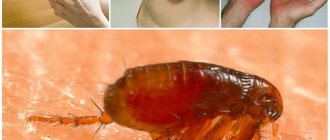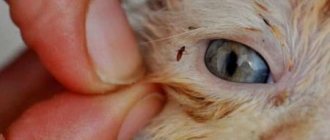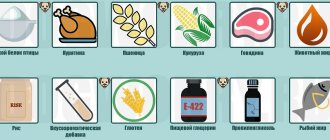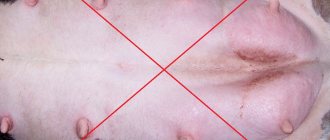Related Posts
- Are fleas dangerous for people and what harm do they cause?
- Flea collar
Does tar soap help get rid of lice and nits: how to prepare it at home
Fleas are a group of wingless insects that feed on the blood of their prey. These parasites are very numerous; scientists have counted more than 209 genera, which include 15 families. Insects that are found in everyday life and bite dogs, cats, rats, chickens and other domestic animals belong to the common family (Pulicidae).
What fleas live on animals
There are a huge number of varieties in nature. They can live on animals, humans and rodents. Each of them is adapted to a certain body temperature, blood and other characteristics of the victim’s body. In the absence of these, the insect can feel great on animals or people in close proximity.
On cats
Their variety: "Ctenocephalides felis". They can be red and brown. On the skin of an animal, they look like particles of dirt, only by their movement, you can understand that it is a flea. The eggs are white particles, similar to grains of rice, only smaller in size. But the female does not lay larvae directly in the fur; she chooses other places for this. This could be: carpeting, upholstery, cracks in the floor and under baseboards. The body has spines and bristles for deft movement along the hairs; the hind legs are shorter than the front ones. Can jump to a height of 1.5 meters.
Some people wonder whether cat fleas can spread to humans - they pass to people 3 times more often than dog fleas. It is also important to know that when bitten, the causative agent of the disease is transmitted to a new victim, if before that they fed on the blood of an infected animal.
On dogs
Their variety: "Ctenocephalides canis". They choose dogs, cats, horses. In times of famine, they will not refuse human blood. They have a flattened body, many bristles, and combs of flat teeth. They can live even in densely populated areas; they can survive without food for about 60 days. The dog flea bites humans and cats if there is no suitable victim nearby. The jump exceeds 4 times the length of the vision, she does not see where she wants to jump. Body length up to 5 mm. Color range: from yellow to dark brown. These parasites also pose a danger to humans in the form of infection with various diseases.
Symptoms of infection and self-diagnosis
The bites of blood-sucking parasites cause irritation and severe itching of the skin in pets, in some cases accompanied by an allergic reaction. As a result, the animal begins to intensively lick the fur, and some of the fleas are removed. Therefore, it is sometimes difficult to understand that a cat or dog is suffering from fleas - the parasites jump on the animal only while feeding.
If you suspect something is wrong, you need to monitor your pet’s condition. If he is attacked, he begins to itch frequently and sharply, most of all in the area of the head and tail. The animal tries to bite insects, sometimes directly biting into itchy places on the body.
The skin in the affected areas becomes irritated and small red bumps and crusty areas may appear along the back and neck. The hair begins to fall out more intensively, and in advanced cases, bald patches appear. Fleas are carriers of helminths, so the presence of worms in an animal's feces indirectly indicates infection by insects.
Signs of fleas on an animal.
Having appeared in the house, parasites spread throughout its territory - they hide in carpets and other woolen products. The pet cannot hide from them anywhere, and its behavior changes. Owners of a cat or dog can recognize attacks by blood-sucking insects by the following signs:
- the animal avoids its usual sleeping place;
- becomes irritable and restless;
- shakes his head vigorously;
- suddenly jumps up;
- makes plaintive sounds or growls.
You can detect insects using a white cloth and a special comb, the teeth of which are arranged in such a way that fleas get stuck in them, or a comb with fine teeth. The pet is placed or laid on a cloth and its fur is combed from head to tail.
Increased attention is paid to areas on the inside of the paws, the back of the neck and at the base of the tail, where insects most often hide.
During the procedure, either fleas themselves are found in an infected animal - brown insects with a flattened body 2-4 mm long, or their eggs and excrement, which look like a mixture of white and black grains. A drop of water should be applied to the suspicious material. If it contains flea excrement, then when wet, the black grains will turn dark red because they contain blood cells. If there are no signs of infection, but the symptoms do not disappear, you should consult a veterinarian.
Can fleas be transmitted to humans?
In this case, the use of “transferred” is completely inappropriate; their presence on the body is short-term. That is, they just need to drink blood and change the body of the victim. This is precisely the goal pursued by blood-sucking insects; they have no other plans for “invasion” on people. Eggs are laid mainly in dark, damp and warm secluded places. If a flea is well-fed, it has no interest in the human body. Until her next appetite awakens, she will live in or near the trash can, on cat and dog supplies.
As soon as they feel signs of hunger, they will begin to attack everyone, indiscriminately. fleas spread to humans when they are present in dangerous places, these include doghouses, pet bedding, basements, and rooms with unsanitary conditions.
Symptoms of a flea bite
You can determine that this bite is a flea, and not another blood-sucking insect, by the following signs:
- pain and burning;
- they bite day and night, they do not have a specific time, unlike bedbugs;
- blisters on the damaged area;
- bites are located at a distance of 2 cm from each other;
- an allergic reaction is possible.
Fleas bite on any open area of the body. Often this is the neck, arms, legs, back (if the blood-sucking parasite has migrated to the bed, sofa, clothes).
The danger of fleas to humans
The danger depends on the type of blood-sucking parasite itself. If, for example, it previously fed on the blood of a sick animal, it may well infect a person through a bite. In medieval Europe, fleas were a sign of an outbreak of plague. Fortunately, no such epidemics have been identified so far. Dangerous diseases that blood-sucking parasites can infect: pulicosis - characterized by severe itching and redness of the skin, dermatitis - severe skin damage. In addition, they can easily infect various hepatitis viruses, typhoid, salmonellosis, and encephalitis. Also, these blood-sucking parasites are the main carriers of various worms, including helminths. If a flea gets into human food, it can lead to intestinal infections.
Are these insects dangerous for the animal owner or not?
It is very important to know how dangerous fleas are for a pet owner who has become ill with parasites. Common bite marks are not harmless: they can have serious consequences:
- Allergy. Usually occurs in people who are prone to similar reactions and often suffer from various irritants. Allergic dermatitis appears on hypersensitive skin. In this case, the allergen is the flea's saliva, which will cause the bitten area to itch for a long time.
- Infection with worms. Parasites are carriers of nematodes, as well as helminths. As a result, dipilidia may develop, during which tapeworms begin to develop in the body. Their largest size in the intestine is 70 cm.
- Bartonellosis. This is a whole group of diseases that differ from each other, but the source of their occurrence is the same - bacteria carried by fleas. All of them pose a potential danger to humans.
All these diseases can be contracted not only at home if your pet catches fleas. But insects can also bite in the entrance, on the street, when interacting with street animals and even with pets.
Fleas can appear in an apartment very easily: you can bring them on shoes or clothes along with dirt.
It is also worth remembering that fleas are capable of giving rise to entire epidemics, which has already happened more than once: they are carriers of typhoid and plague. Therefore, we must not forget about prevention: check your pet as often as possible for the presence of these unpleasant and dangerous insects.
Flea control
These parasites can be brought into your home after visiting an attic, basement, unsanitary room, and even after a walk. In order to prevent their appearance in the home and on animals, the following measures must be taken:
- When walking in the fresh air (in the park, in the local area, and wherever it may be), animals should wear special collars to repel blood-sucking parasites.
- Periodically wash and disinfect rugs and other pet supplies. Wash with bleach and other chlorine-containing products several times a month.
- Several times a week, and in the summer season, you can vacuum the upholstery of upholstered furniture, carpets, and rugs every day.
People who do not know that fleas are transmitted to humans should promptly treat their pets for blood-sucking parasites. But, if there are no dogs, cats or other living creatures in the house, it is necessary to treat the premises with disinfectants, since fleas can also be earthen fleas.
How to identify fleas in an apartment
There are several ways to detect these insects in your home. To do this, you need to conduct a focused search and be a little observant.
By parting your pet's fur, you can detect pest excrement.
Examine your pets carefully. Look behind the ears, on the front legs and at the base of the skull. Evidence of infection is the presence of bloody spots on the skin. This is also evidenced by constant scratching of the body caused by excessive itching.
In the photo: flea eggs and larvae
Bathing the animals will also help determine the presence of parasites. Their brownish-red bodies will float in the water. When washing the wool, you can see how they fall out into the bath and this is already a reason to use special shampoos.
The appearance of itchy red bumps on your body are signs of flea bites. Insects can hide in the folds of bed linen, in a mattress, in a pillow, from where they attack a person at night. They can also be found in fleecy clothing or warm socks.
To detect flea droppings on carpet, just walk on it in white socks and check for marks on the soles.
Prevention against fleas
No owner likes the appearance of blood-sucking parasites. Therefore, many are interested in the question: can fleas spread to humans.
To prevent infection, you must follow the recommendations below:
- After each walking of pets, they must be treated with special means. This includes shampoos and decoctions based on various plants, including wormwood.
- Use pine sawdust in bedding and other animal accessories. When you bathe your pet, wash with laundry soap.
- To avoid becoming infected with fleas from under a shaft or other premises with unsanitary conditions, treat it with chlorinated water or ammonia. Also, some owners recommend scattering wormwood bushes or sawdust in the corners.
Based on all of the above, one simple conclusion should be drawn: even if you put a rag soaked in a chlorinated solution on the threshold, this is also a preventative measure.
How to fight?
How to rid your pet of annoying parasites? There are several effective ways:
- Shampoo. You can buy a special shampoo that kills fleas. It contains insecticides that do not leave insects the slightest chance. The product is used as usual, which is used for regular washing: applied to the wool, foaming well with your hands. Then you need to wait a little for the composition to take effect and rinse off. Shampoos are good because they prevent relapses: fleas will not return in the near future.
- Collar. It is more of a preventive remedy that repels insects that want to feed on the animal’s blood. The disadvantage of using it is that the collar does not destroy fleas that already live on the cat.
- Drops. An inexpensive and effective remedy that allows you to get rid of parasites in a short time. The drug purchased at a veterinary pharmacy is dripped onto the withers or any other inaccessible place on the animal’s body so that it does not lick off the substance. Soon the substances spread throughout the epidermis, accumulate inside and have a detrimental effect on fleas.
- Spray. It has the same effect as drops. It differs in the method of application: the owner sprays the composition over the skin and fur of the animal. You need to make sure that the cat does not lick itself for a while until the spray dries. This product is also applicable to bedding, carpets, and household items in which cat fleas live.
Remember that by ridding an animal of parasites, you do not protect it from re-infection. After all, very often fleas accumulate in an apartment, and wet cleaning only multiplies - they love high humidity. Even frost does not scare them.
Therefore, after treating a flea-bearing cat, you need to take care of the apartment: disinfect it with special means. But many of them are toxic, so after the procedure it is advisable to leave for a while and take your pet with you.
Cat fleas do not live on humans, but they can cause a lot of trouble and trouble in the form of bites.
If you notice that your animal is itching frequently, examine it and take action if you find signs of flea bites. The sooner you do this, the easier it will be for you: removing a small number of parasites that have not yet had time to reproduce is not as difficult as using countermeasures for an entire nursery.
Don't forget about prevention - let your cat wear an anti-flea collar, and then the risk of becoming infected with parasites will be reduced to zero.
Reviews
Some people experience flea bites, and it is worth noting that only some of them suffer an allergic reaction. This is mainly due to diseases such as diabetes. People with this diagnosis are very sensitive to the bites of these blood-sucking parasites.
“I, Anna Nikolaenko, 59 years old, gardener. These “bloodsuckers” got the better of me when I moved to the dacha. I overcame them with the help of folk remedies. There was a lot of free space near the country house, so I decided to plant different flowers. But I don’t know exactly which one helped. I also read on the Internet and chose products based on people’s reviews.”
“I, Kristina Smirnova, 20 years old, live in the private sector. I want to tell my story. It happened like this: I was sitting on the couch, watching my favorite TV series, and felt a bite. I didn’t scratch it right away and decided to take a look. And there’s a black spot there, and it’s moving. I decided that I would catch it and crush it now. She jumped a few meters away from me and got scared herself. There were no more experiments, I decided to act quickly and sharply.”
This is just an excerpt from existing reviews; they can be found on forums and websites. After all, it is there that people share their folk recipes and how to prevent the appearance of fleas in a living room.
Watch the video - do fleas from animals live on people:











